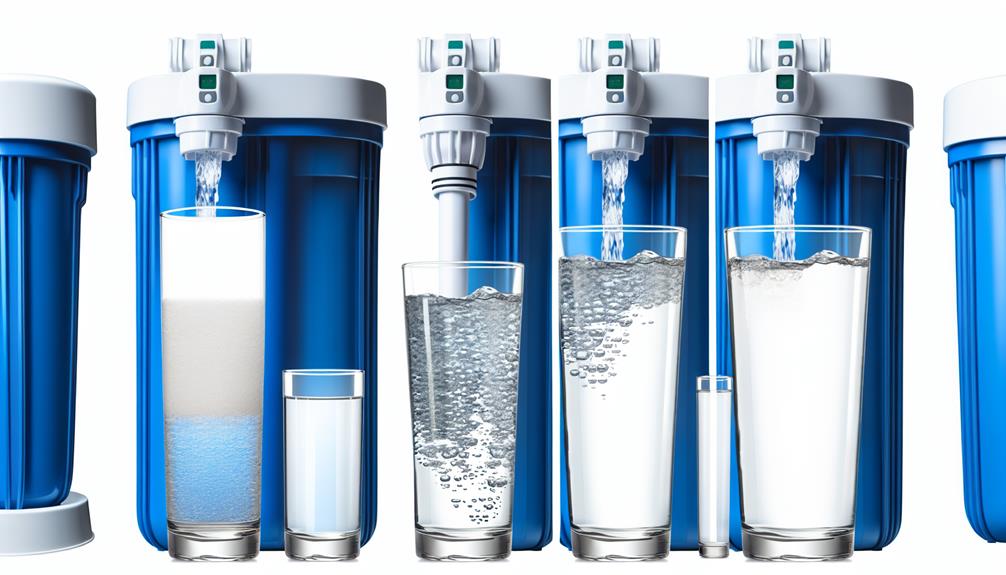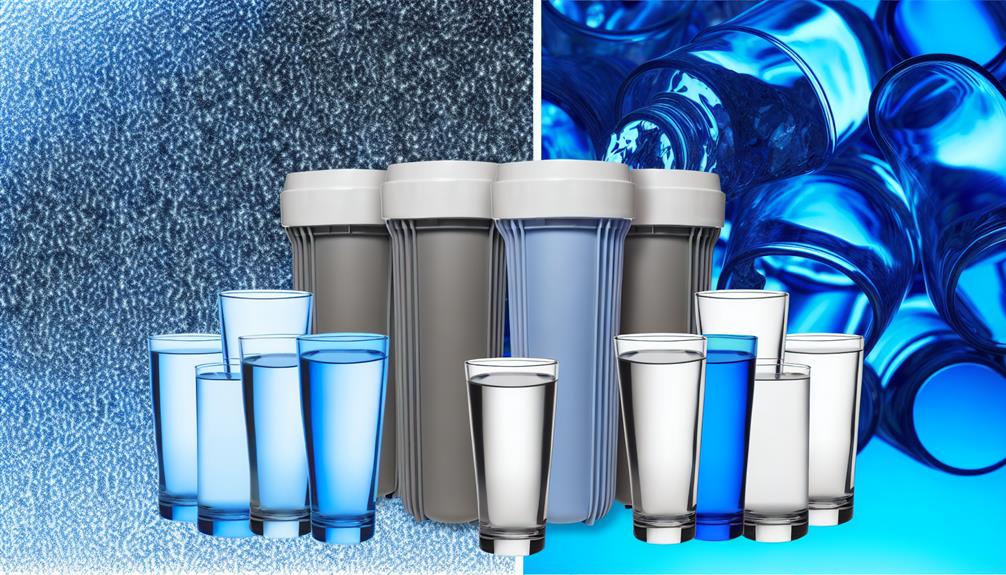You’d sooner find a desert without sand than a traveler without the need for clean water. As you traverse the globe or hike through backcountry trails, the importance of staying hydrated with pure, uncontaminated water cannot be overstated.
Now, you’re faced with a myriad of choices, each promising to be your best ally against pathogens and pollutants. From ultraviolet light purifiers that claim to zap away bacteria, to gravity-fed systems that patiently cleanse your water drop by drop, the options can be as overwhelming as a bustling city square.
Whether it’s a pump-action unit, a straw-style filter, or a chemical solution you’re considering, we’ve distilled the information down to the seven best portable water purifiers on the market.
As you prepare for your next adventure, remember that the right purifier isn’t just an accessory—it’s your ticket to safe hydration in unknown territories. Stick with us to uncover which purifier might just become your most trusted travel companion, ensuring that no matter where you find yourself, the last thing you’ll have to worry about is your next sip of water.
UV Light Purifiers Explained
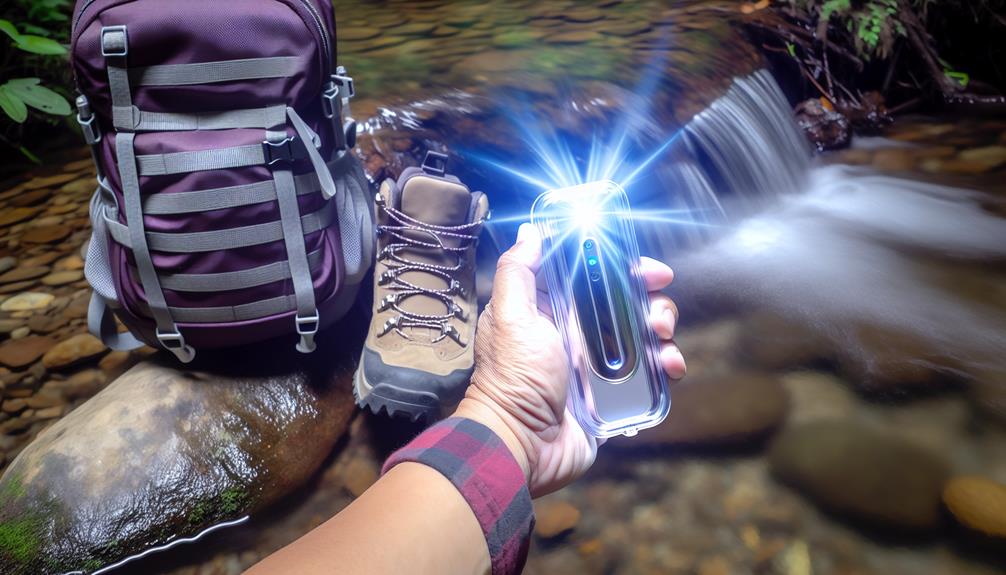
UV light purifiers harness the power of ultraviolet light to eliminate microorganisms in water, offering travelers a compact and efficient method of ensuring water safety. These devices typically employ a small UV lamp that radiates light into a water container, targeting the DNA of bacteria, viruses, and protozoa. This radiation disrupts their reproductive processes, rendering them harmless.
Purification efficiency is critical when evaluating UV light purifiers. Most are designed to meet or exceed the relevant standards for water purification, capable of neutralizing over 99.9% of pathogens. However, the effectiveness can vary based on the clarity of the water and the exposure time. Murky water with a high level of sediments may require pre-filtration or longer exposure to UV light to achieve the same level of purification.
Battery life is another crucial aspect to consider. Your purifier’s battery determines how long you can use it before needing a recharge or replacement. Some models boast extended battery lives, allowing for multiple uses on a single charge, which is particularly beneficial for longer trips or areas with limited access to electricity. It’s essential to check the manufacturer’s specifications regarding battery life and plan your usage accordingly to ensure consistent access to safe drinking water.
Gravity-Fed Water Systems
Moving away from electrical solutions, gravity-fed water systems offer travelers a simple, yet effective, method for purifying water by utilizing the natural force of gravity. These systems are particularly invaluable during mountain treks and in scenarios where emergency preparedness is crucial. They work by allowing water to move through a filtration element solely by the pull of gravity, eliminating the need for pumping and electricity.
Analyzing these systems’ efficiency reveals that they are adept at filtering out a myriad of contaminants, including bacteria, protozoa, and often even viruses. Their portability and ease of use make them a favorite among adventurers and survivalists alike. However, the flow rate and the volume of water they can purify at a time can vary, which is something you’ll need to consider based on the size of your travel group and water needs.
To engage you further, here’s a comparative table of some features of gravity-fed systems:
| Feature | Benefit |
|---|---|
| No Power Required | Ideal for remote locations, ensuring continuous use |
| High Volume Capacity | Suitable for groups, less frequent refilling needed |
| Simple Maintenance | Cleaning and replacing filters is typically hassle-free |
Pump-Action Filtration Units
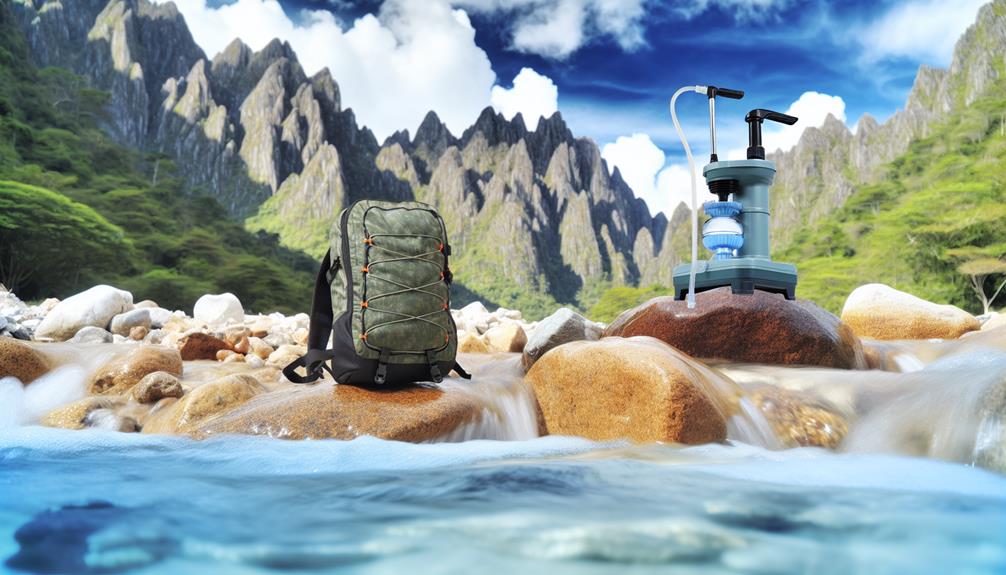
For travelers seeking a more hands-on approach to water purification, pump-action filtration units provide a reliable method for ensuring access to clean water when outlets and passive systems aren’t an option. These devices require manual effort, as you must physically pump water through a filtration mechanism. The force you apply drives the water through a series of filters that trap contaminants and pathogens, rendering the water safe for consumption.
The effectiveness of pump-action purifiers hinges on both the quality of the filters and the user’s diligence in operation. An analytical look at these systems shows that filter longevity is a critical aspect, influencing both the cost-efficiency and the practicality of the unit over time. Long-lasting filters reduce the need for frequent replacements, which is particularly beneficial during extended travel or in remote locations.
You’ll find that despite the manual effort involved, pump-action units offer a dependable purification process. They’re capable of processing larger volumes of water compared to UV light purifiers or chemical treatments, which is ideal for group travel. However, since they require physical labor, your willingness to exert consistent effort must be weighed against the unit’s ability to provide ample clean water without the aid of electricity or gravity.
Straw-Style Filter Devices
You’ll find that straw-style filter devices offer a high level of portability due to their compact design.
Understanding how to properly use and maintain these filters ensures they remain effective and prolongs their lifespan.
It’s crucial to consider the compatibility of these devices with various water sources you may encounter on your travels.
Compact Straw Filters
Compact straw filters, resembling a thick straw, offer a lightweight and convenient solution for purifying water directly from the source while traveling. When evaluating these devices, you should consider:
- Filter Lifespan: A longer filter lifespan means less frequent replacements and greater convenience.
- Flow Rate: A higher flow rate allows for quicker hydration without strenuous sucking.
- Contaminant Removal: Analyze the types of pathogens and particulates the filter can remove to ensure safety.
- Material Durability: Robust materials extend the filter’s usability and prevent breakage in transit.
Usage and Maintenance
Understanding how to properly use and maintain your straw-style filter is crucial for ensuring its effectiveness and longevity.
Initially, familiarize yourself with the manufacturer’s instructions to optimize filter longevity. Typically, you’ll immerse the straw in water and sip through it, letting the internal filtration system do the work.
Post-use, cleaning procedures are essential. Most straw filters need to be backflushed to remove contaminants and prevent clogs. This often involves blowing air through the filter in the reverse direction of water flow. Some models may require specific cleaning tools or tablets.
Regular maintenance not only prolongs the filter’s life but also ensures the quality of water you’re drinking remains uncompromised. Store the device in a cool, dry place to avoid mold and mildew buildup.
Water Source Compatibility
When selecting a straw-style water purifier for travel, it’s essential to consider the compatibility with various water sources you may encounter. These devices are designed to be versatile, but their efficacy can vary depending on the water they’re filtering. Here’s what to keep in mind:
- Clear Running Water: They work best with clear, running water, reducing bacteria and parasites effectively while often preserving mineral retention.
- Stagnant Water: Can be used, but the risk of clogging increases, potentially affecting taste impact and flow rate.
- Turbid Water: Pre-filtering is advisable to enhance the straw’s efficiency and longevity.
- Chemically Contaminated Water: Most straw filters don’t remove chemicals or viruses, so consider the presence of such contaminants before use.
Researching your destination’s water quality can guide your choice.
Bottle Filters for Travelers
For many travelers, bottle filters have become an indispensable tool for ensuring access to safe drinking water while exploring different parts of the world. Maintaining travel hygiene is a significant concern, and a reliable bottle filter can mitigate risks associated with contaminated water sources. When selecting a bottle filter, it’s essential to consider the filter lifespan, which is typically measured in the number of liters it can purify before requiring replacement. A longer lifespan means less frequent replacements, making it more convenient and cost-effective for extended trips.
Analyzing the technical specifications of bottle filters reveals that most utilize activated carbon and other advanced technologies to remove pathogens and chemicals. Some are equipped with a pre-filter to extend the main filter’s effectiveness. The flow rate is another critical factor, as it determines how quickly you can hydrate—a crucial aspect during strenuous activities or in hot climates.
Unbiased comparisons show that not all bottle filters are created equal. They vary in weight, size, durability, and purification capabilities. For instance, some may only eliminate bacteria and protozoa, while others can also filter out viruses. It’s important to match the filter’s abilities with the destination’s water safety concerns to ensure you’re adequately protected.
Chemical Purification Solutions
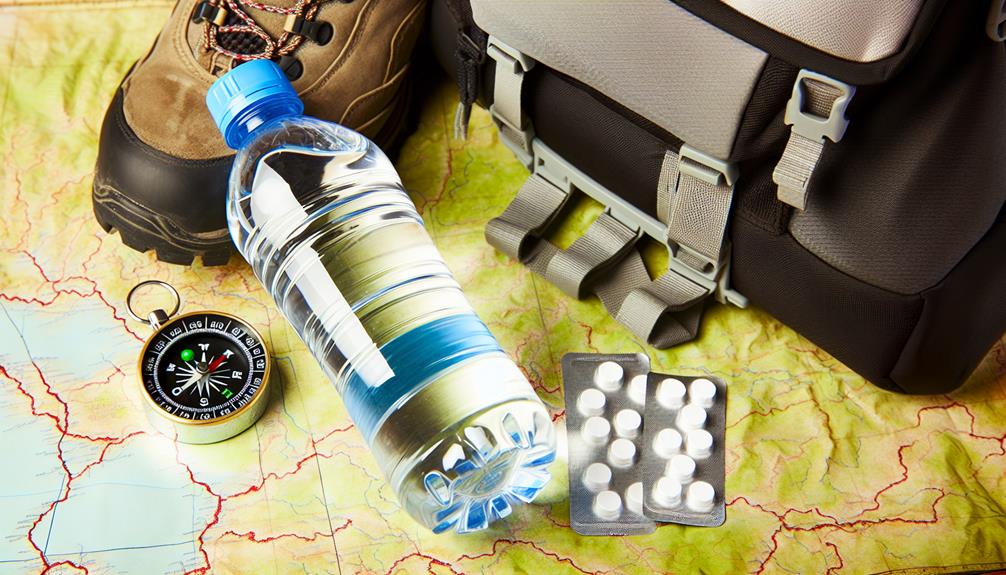
Aside from mechanical filtration, chemical purification solutions offer travelers an effective method for treating water, using substances such as iodine or chlorine to kill pathogens. These chemical treatments are lightweight, easy to pack, and have a long shelf-life, making them a practical choice for your adventures. However, it’s essential to understand their implications on both water quality and user experience:
- Chemical Effectiveness: Iodine and chlorine solutions are highly effective against a broad spectrum of microorganisms, including bacteria, viruses, and protozoa. However, their efficacy can be diminished in turbid or cold water.
- Contact Time: For optimal effectiveness, treated water usually needs to stand for a certain period, often 30 minutes to four hours, depending on the water temperature and the concentration of the chemical used.
- Chemical Residue: After treatment, a slight chemical residue may remain in the water. This can potentially affect the taste and smell. Some products include neutralizing agents to address this issue.
- Taste Alteration: Both iodine and chlorine can alter the natural taste of water. While some travelers are indifferent to this change, others might find it unpleasant.
In analyzing these chemical purification solutions, it’s clear they provide a balance between convenience and effectiveness. Understanding the nuances of their use ensures you make an informed choice for safe hydration on the go.
Personal Filtered Drinkware
As you consider personal filtered drinkware for your travels, it’s essential to evaluate the innovative filtration technology they employ. You’ll want to weigh their durability and maintenance requirements against your travel needs, ensuring longevity and ease of use.
Additionally, the compact design features of these purifiers are crucial for maximizing convenience and minimizing space in your luggage.
Innovative Filtration Technology
While exploring remote destinations, travelers often rely on innovative filtration technology in personal filtered drinkware to ensure safe drinking water. These advanced systems commonly use:
- Ceramic Cartridges: Porous ceramic filters out bacteria and protozoa by size exclusion, trapping pathogens while allowing water to pass through.
- Nanotechnology Applications: Nanofibers or nanoparticles target and remove even the smallest contaminants, including viruses.
- Activated Carbon: This component adsorbs chemicals and improves taste and odor, enhancing the overall drinking experience.
- UV Light Purification: Some bottles incorporate UV-C light to kill microorganisms, providing an extra layer of protection.
This multifaceted approach to water purification allows you to stay hydrated without compromising on safety or quality, no matter where your adventures take you.
Durability and Maintenance
When selecting a portable water purifier for travel, it’s crucial to consider its durability and the ease of maintenance to ensure long-term reliability and effectiveness. Analyze the materials and construction to assess whether the purifier can withstand the rigors of travel. Filter lifespan is a key factor; a longer lifespan means fewer replacements and less hassle. Replacement costs are also significant as they contribute to the overall expense of maintaining your purifier.
| Aspect | Consideration |
|---|---|
| Material Quality | Determines the purifier’s resilience to wear and tear. |
| Filter Lifespan | Impacts frequency of replacements and long-term value. |
| Maintenance Ease | Influences the time and effort required for upkeep. |
| Replacement Cost | Affects the ongoing investment in your purifier’s performance. |
Choose a model that balances these factors to provide a practical, cost-effective solution for safe drinking water on the go.
Compact Design Features
In the realm of personal filtered drinkware, compact design features are paramount for travelers who require convenient access to clean water without the burden of carrying bulky equipment.
- Size considerations: Optimal designs prioritize a balance between a purifier’s physical dimensions and its capacity to store or filter water, ensuring it fits comfortably inside standard luggage or backpacks.
- Material types: The choice of materials, such as BPA-free plastics or lightweight metals, can significantly affect both the weight and durability of the purifier, as well as its safety for storing drinking water.
- Collapsible structures: Some purifiers incorporate flexible materials that allow for them to be collapsed or folded, dramatically reducing their size when not in use.
- Integrated systems: Features like built-in carabiners or loops facilitate attachment to gear, and retractable mouthpieces or straws provide additional space efficiency without compromising functionality.
Conclusion
In conclusion, you’ve got a variety of portable water purifiers to choose from, each with its own merits.
Whether you’re drawn to the convenience of UV light purifiers, the group-friendly gravity-fed systems, the robustness of pump-action units, the simplicity of straw-style filters, the practicality of bottle filters, the assurance of chemical solutions, or the personal touch of filtered drinkware, there’s a solution that suits your travel needs.
Analyze your preferences and select wisely to stay hydrated and healthy on the go.
